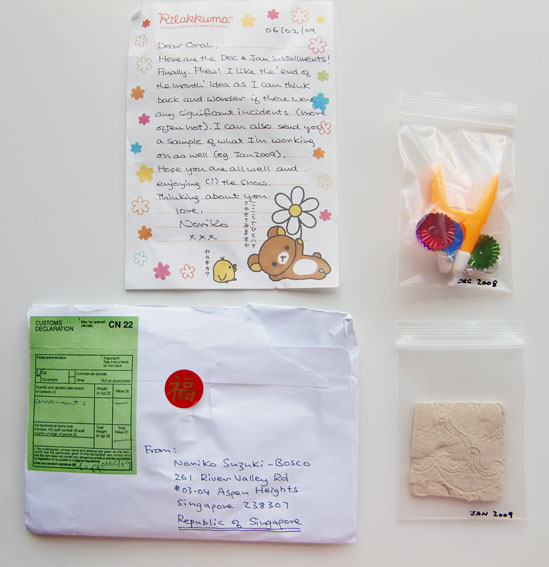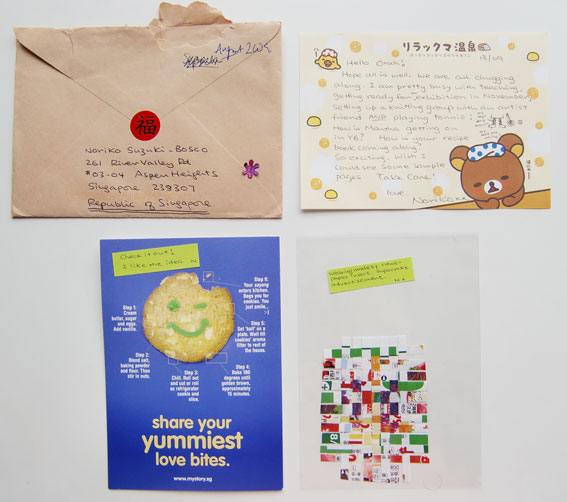
August 2009, freebie recipe postcard and woven advertisement paper
| Like knitting, there is something quite satisfying about the process of weaving where individual pieces of thread (wool, paper, etc) turn into a solid flat thing. August 2009 piece was a small woven piece using colourful advertisement paper from Japan.
My friend recently sent me an image of the winter blue sky in Tokyo. If you look closely, you can see Mt Fuji in the distance. I could almost smell the air. The blue was so nostalgic.
I cut up the image into thin strips and enjoyed the process of weaving back together the winter Tokyo sky. The blue sky slowly took its form in front of my eyes.
|
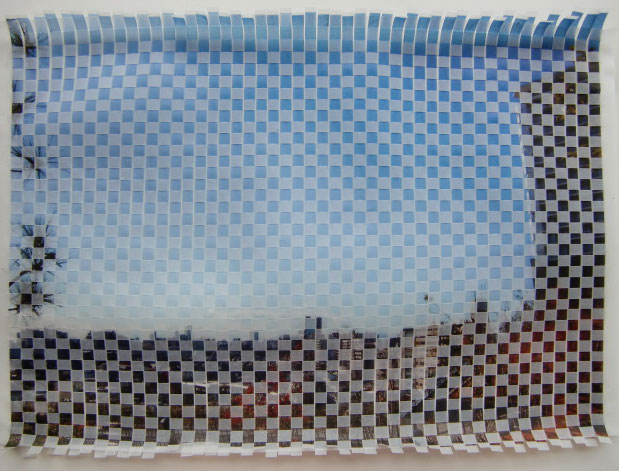
'Winter Tokyo Sky', ink jet print on tracing paper. 21 January 2014
|
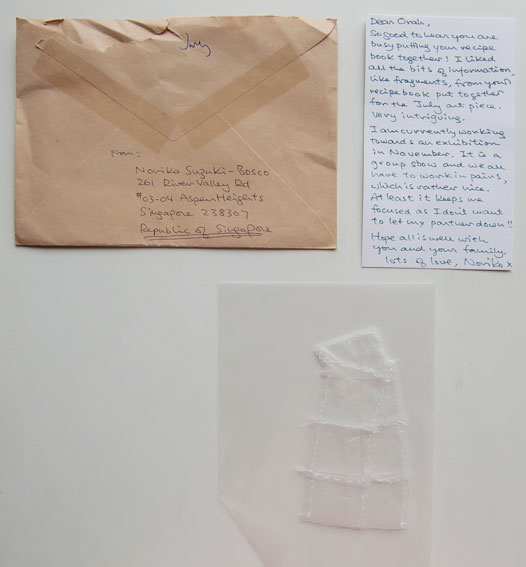
July 2009 : small paper house made of parchment paper
| Parchment paper or grease proof paper is another of my favourite papers to work with. I enjoy the translucent quality and its association with everyday activities like baking.
For July 2009, I stitched a small house of multiple stories using parchment paper. It was a 3 dimensional house but by the time Orah received it, it was completely flattened in the post.
I made a series of 2 dimensional multi-story houses, already flat, sandwiched between two sheets of parchment papers. These were the pieces for my new work.
The little houses look like they are enveloped in a mist of fog. You have to look very closely otherwise they may disappear forever. It is like trying to hold on to a memory that is slipping away.
|

'Paper Houses', parchment paper, thread, graphite, 15 January 2014
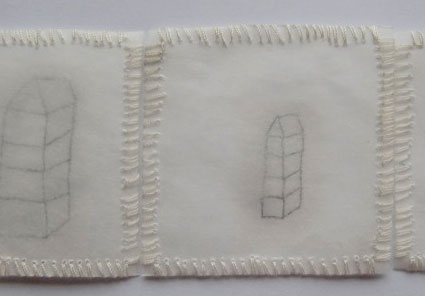
'Paper Houses' - detail
|
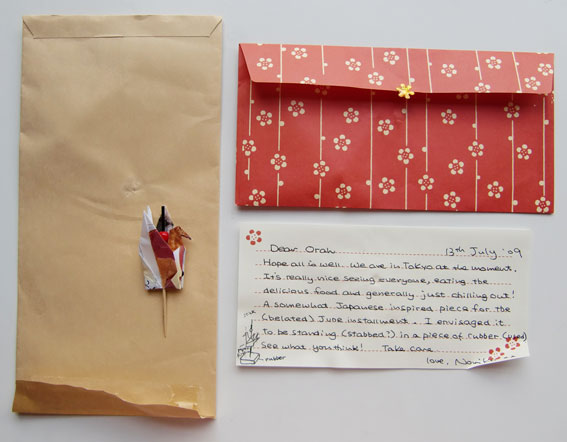 June 2009: paper crane made from advertisement paper pierced with an ornamental toothpick, Japanese style letter paper | In Japan, colourful advertisement papers are the everyday norm. They get delivered to you inserted in the local newspaper. They tell you what are on offer in the local supermarkets, the rooms for sale in the newly built apartments, even pets and cars are all advertised in these papers. I love them because they give you a glimpse into an imaginary lives of the will be consumers, me being one of them.
I cut out a small square from an advertisement paper and folded a crane for the June 2009 work. I found interesting the juxtaposition of making an art work from such mundane, throw-away material.
I happened to have some of this advertisement paper with me in Winchester. I decided to use them again for the current piece. I cut out even tinier square pieces from the various colourful papers and turned them into a meticulously created mosaic.
But the vibrant mosaic piece did not really do anything for me. It seemed somehow out of place. Intuitionally I covered it with layers and layers of tracing paper, depicting images of boxes. I layered it until I knew it was covered enough. The piece seems to fit my psyche and my surrounding now.
| 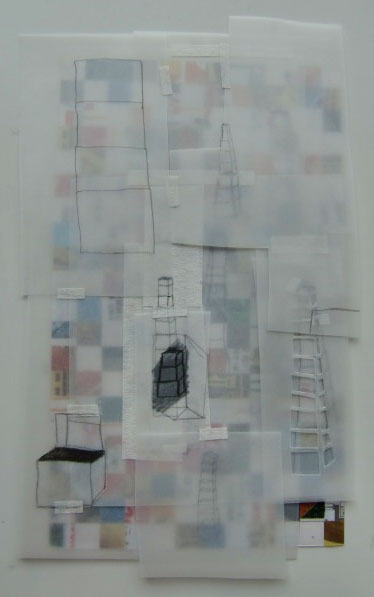 'Boxes', advertisement paper, tracing paper, graphite, ink, masking tape, 13 January 2014 |
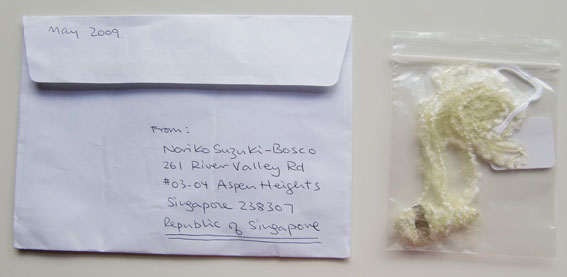
May 2009 : a small key wrapped up in very soft, light green wool
| Keys are interesting objects. They can lock up but they can also open. I like the dual quality of being able to hide and reveal with a key.
I don’t know where the key I used for the May 2009 piece came from. It is small and silver. Maybe it is one of the keys for a padlock or a suitcase. Where it originated from is hardly the matter as now it is wrapped up in soft, green wool, looking more like a cocoon waiting to turn into a beautiful butterfly.
I thought about unraveling the green wool and using it for the current piece but decided against it as the key looked so snug. So instead, I painted colouful round circles and photocopied my house keys that I always keep in my jeans pocket.
The image of the keys looked too exposed amongst the colouful circles and the stitch marks so I covered it up with tiny pieces of tracing paper, like blanket of snow.
|
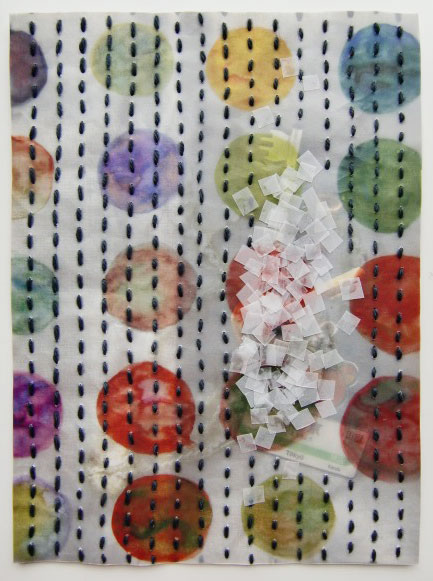
'Keys', tracing paper, Indian handmade paper, thread and watercolour, 08 January 2014
|
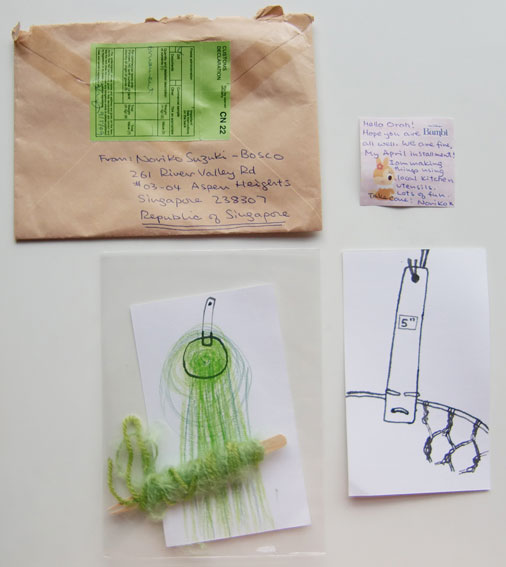 April 2009 | Kitchen utensils provide an intriguing insight into local cuisines. In Singapore, I loved the large wire mesh colanders used for draining noodles and the flat spoon for scooping out tofu.
I wanted to create a series of work using local kitchen utensils. April 2009 pieces reflect that - an ink drawing of the mesh colander and a bamboo pick wrapped up in soft green wool. I remember being keen to create a body of work that connected me specifically to Singapore.
I unraveled the green wool from the bamboo pick and stitched it onto tracing paper. The shape reminded me of a boundary, of inside and outside.
In order to accept differences of any kind, one has to be flexible about their boundary. I hope mine will always be flexible like the shape drawn by the green wool.
| 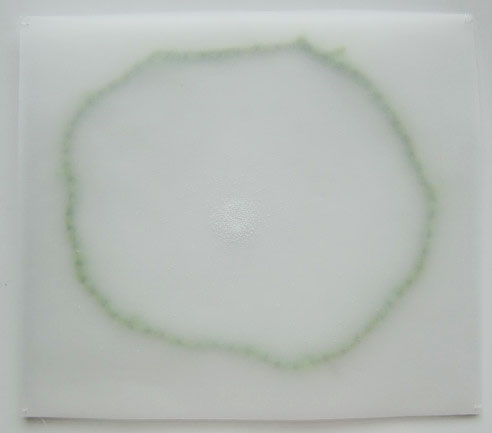 'Boundary', wool, cotton, tracing paper, 19 December 2013 |
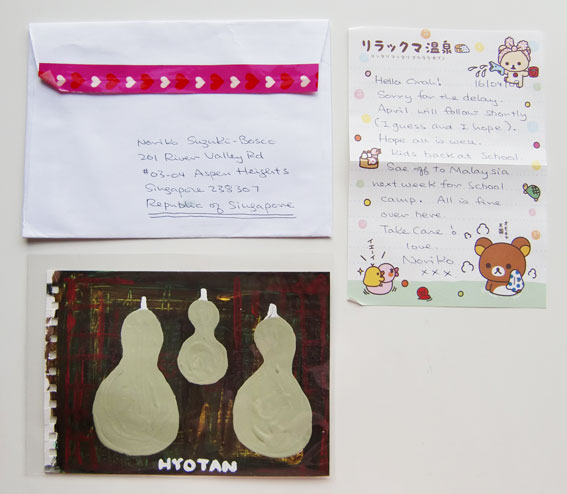
March 2009
| A painting of three ‘hyotan’ (gourds) for March 2009. Hyotan is a symbol of good luck in Japan. I don’t think the work has any particular connotations of good luck but I remember using a lot of ‘Japanese’ images in my works I was making at that time. Hyotan probably caught my eyes as something that looked very traditionally Japanese.
I replaced the three hyotan with three boxes, hiding one of the box behind the tracing paper.
I am getting quite good at using the half transparent tracing paper as a screen. I like the way it hides and reveals things at the same time.
It reflects my situation here too – kind of here but not really. Neither here nor there. It’s ok though. I am not complaining.
|
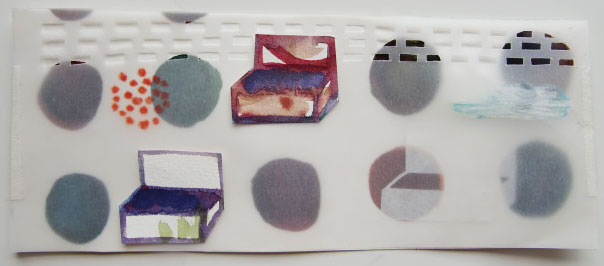
'Three Boxes', watercolour, watercolour paper, tracing paper and crayon, 18 December 2013
|
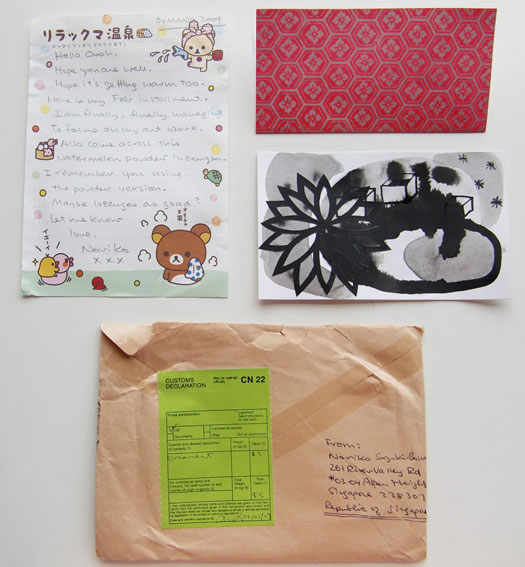
February 2009
| Cutting out paper is a therapeutic process, similar to stitching. Different cultures have different paper cutting art. I saw a lot of Chinese paper cutting designs in Singapore, especially at Chinese New Year time.
Japan has Monkiri paper cutting. February 2009 work shows my attempt at this combined with black ink stain. And boxes! What is it with boxes? They appear in many of my works.
Repetitive pattern taken from traditional Japanese paper were cut out from the tracing paper. This acted as a screen for my current work. The stacked boxes hover behind the ornate, half transparent screen and also stand autonomously, on its own. Containing what? Why are they here? Are they waiting to be sent off or to be unpacked?
|
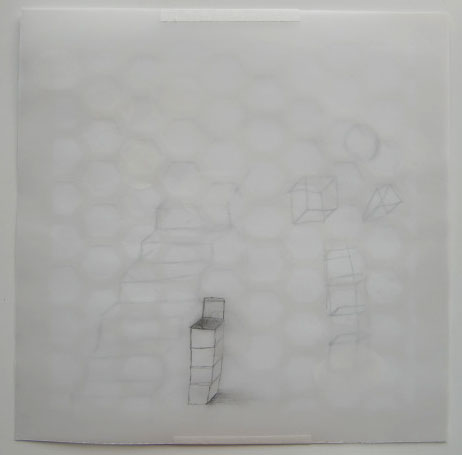
'Stacking (boxes)', tracing paper and graphite, 17th December 2013
|
| | It is currently December and everywhere is decked out with Christmas decoration. Singapore does Christmas very well too. More glitzy and commercial than here. Maybe the work for December 2008 reflected this - a collection of shiny sequins in a small plastic bag.
January 2009 work was a small piece of clay with lace imprint. The square pieces were used for a group of small houses I was constructing. The houses looked and were more flimsy than the straw house in ‘The Three Little Pigs’.
I remembered the little houses. For me, the construction of the little houses and trying to make them stand was a matter of serious importance.
Whether they are little clay walled houses stuck together with PVA glue or the brick and mortar job, a house is a house. There is something fundamental about wanting to build your own house.
|
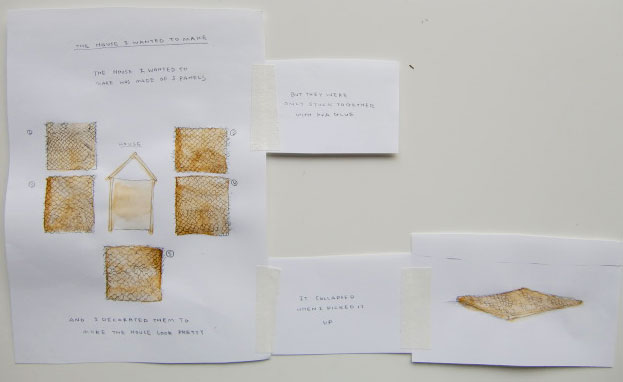
'The House I Wanted to Make', watercolour and mixed media on paper, 13 December 2013
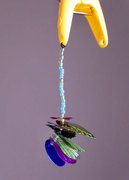
work created from Dec 2008 pieces, 13 December 2013
|
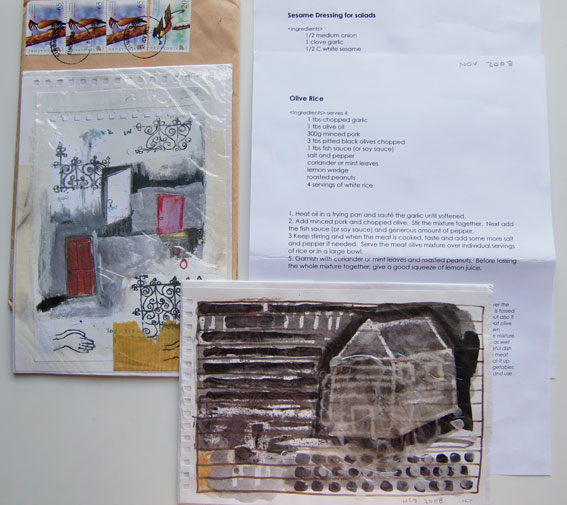 October/November 2008 | A recipe for sesame seed dressing and olive rice were included in the October/November 2008 art works. I had tried olive rice in the food court recently and had found it rather nice. I probably wanted to share the recipe with Orah.
With the recipes were the drawings. One of a house covered in speckled wax and the other, a photocopy of an art piece I had made for a postcard exhibition I was taking part in which I had then made into a collage.
The sesame seed dressing, I still make quite often. Even here, back in Winchester. Olive rice, I really should try. I can get hold of all the ingredients.
It is over 3 months since I have been back. Things are ticking over. I was able to look through Mrs Lee's cookbook recently without feeling dejected but more with a sense of nostalgia.
What does this mean? Am I getting used to being here? Am I feeling more 'at home'? But where is home when memory keeps changing its shape?
When does a house become a home? | 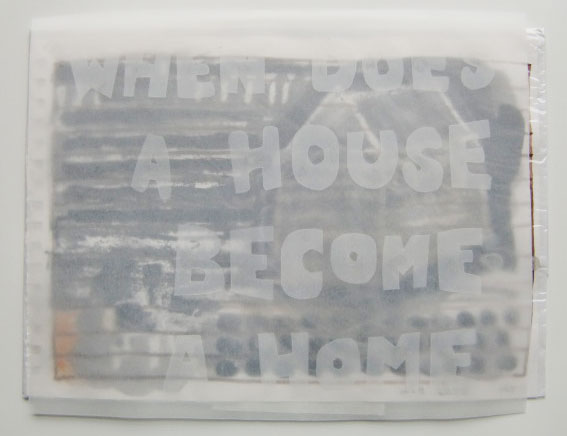 10 December 2013 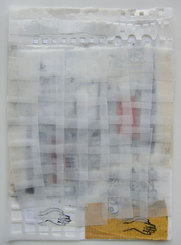 11 December 2013 |
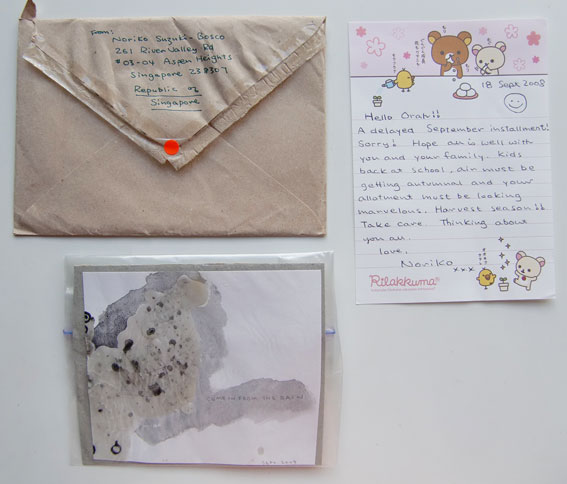
September 2008
| Life must have been carrying on as usual in Singapore. No mention of any catastrophe or major set backs in the letter sent to Orah.
A small work with squiggly line drawing of a house covered in melted wax and the words 'come in from the rain' was my piece for September 2008. I like how wax makes paper translucent.
A house is generally understood as a protective space, a place where shelter and warmth are provided. But a house hidden by melted wax is difficult to find, although the words ask you to come in from the rain.
Today it was dense fog outside. I have hidden the house behind this dense fog. I am still trying to find it. |
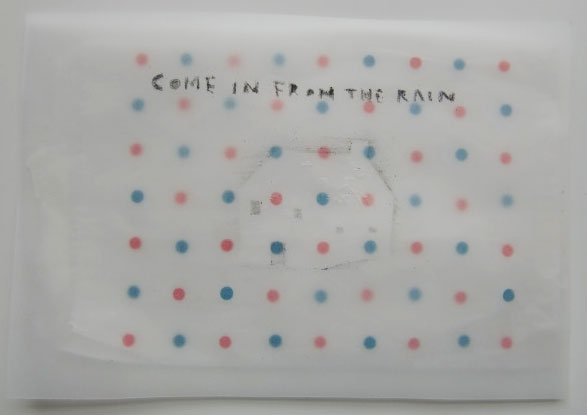
09 December 2013
|
|















